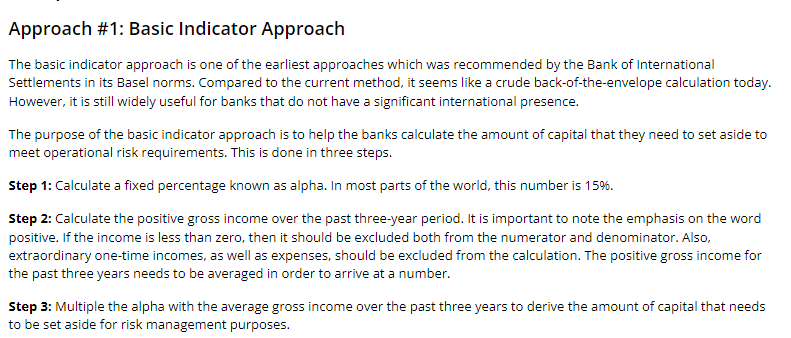please explain how Basic indicator approach helps mitigate operational risk
Foundations of Business (MindTap Course List)
6th Edition
ISBN:9781337386920
Author:William M. Pride, Robert J. Hughes, Jack R. Kapoor
Publisher:William M. Pride, Robert J. Hughes, Jack R. Kapoor
Chapter15: Using Management And Accounting Information
Section: Chapter Questions
Problem 6DQ
Related questions
Question
please explain how Basic indicator approach helps mitigate operational risk

Transcribed Image Text:Approach #1: Basic Indicator Approach
The basic indicator approach is one of the earliest approaches which was recommended by the Bank of International
Settlements in its Basel norms. Compared to the current method, it seems like a crude back-of-the-envelope calculation today.
However, it is still widely useful for banks that do not have a significant international presence.
The purpose of the basic indicator approach is to help the banks calculate the amount of capital that they need to set aside to
meet operational risk requirements. This is done in three steps.
Step 1: Calculate a fixed percentage known as alpha. In most parts of the world, this number is 15%.
Step 2: Calculate the positive gross income over the past three-year period. It is important to note the emphasis on the word
positive. If the income is less than zero, then it should be excluded both from the numerator and denominator. Also,
extraordinary one-time incomes, as well as expenses, should be excluded from the calculation. The positive gross income for
the past three years needs to be averaged in order to arrive at a number.
Step 3: Multiple the alpha with the average gross income over the past three years to derive the amount of capital that needs
to be set aside for risk management purposes.
Expert Solution
This question has been solved!
Explore an expertly crafted, step-by-step solution for a thorough understanding of key concepts.
Step by step
Solved in 2 steps

Recommended textbooks for you

Foundations of Business (MindTap Course List)
Marketing
ISBN:
9781337386920
Author:
William M. Pride, Robert J. Hughes, Jack R. Kapoor
Publisher:
Cengage Learning

Foundations of Business - Standalone book (MindTa…
Marketing
ISBN:
9781285193946
Author:
William M. Pride, Robert J. Hughes, Jack R. Kapoor
Publisher:
Cengage Learning

Foundations of Business (MindTap Course List)
Marketing
ISBN:
9781337386920
Author:
William M. Pride, Robert J. Hughes, Jack R. Kapoor
Publisher:
Cengage Learning

Foundations of Business - Standalone book (MindTa…
Marketing
ISBN:
9781285193946
Author:
William M. Pride, Robert J. Hughes, Jack R. Kapoor
Publisher:
Cengage Learning